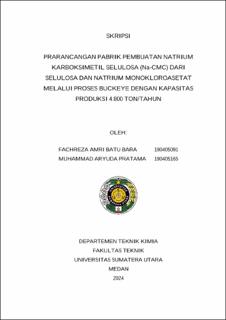| dc.description.abstract | Na-CMC is a high molecular weight compound resulting from cellulose
modification. Na-CMC is widely used in various industries as a thickening agent,
water binder, foaming agent, moisture-retaining agent, and coating agent.
Na-CMC is most commonly used in the food industry. Currently, Indonesia's
demand for Na-CMC is largely reliant on imports, while domestic consumption is
increasing. Therefore, it is necessary to establish a Na-CMC plant to meet the
domestic demand for Na-CMC. The preliminary design of the Na-CMC plant from
cellulose and sodium monochloroacetate through the Buckeye process has a
production capacity of 4,800 tons per year. The main processes in this plant design
consist of three stages: raw material preparation, reaction stage, and Na-CMC
purification stage. The plant is planned to be located in the Special Economic Zone
(KEK) of Sei Mangkei, Kelapa Sawit Street, Subdistrict of Bosar Maligas,
Simalungun Regency, North Sumatra, with a total land area of 15,551 m², 170
workers are needed, and the business entity will be in the form of a limited liability
company (PT.), led by a chief director with a line and staff organizational structure.
The establishment and operation of the plant will require an investment capital of
IDR 1,040,398,035,212 and production costs of IDR 868,295,099,028, with sales
revenue of IDR 936,000,000,000, resulting in a net profit of IDR 144,483,480,804.
Based on the economic analysis, this plant has a Profit Margin (PM) of 22.043%,
Break-Even Point (BEP) of 42.081%, Return on Investment (ROI) of 13.887%,
Return on Network (RON) of 23.146%, Pay Out Time (POT) of 7.2 years
(86 months), and an Internal Rate of Return (IRR) of 9.399%. Based on the results
of economic analysis, it can be concluded that this plant is feasible to establish. | en_US |


